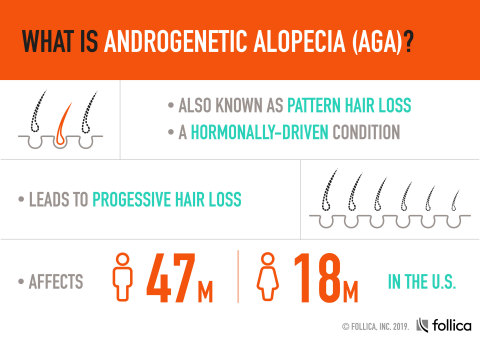Demonstrated 44% improvement over baseline of visible (non-vellus) hair count, a well-established hair growth measure (p value < 0.001)
- Demonstrated 44% improvement over baseline of visible (non-vellus) hair count, a well-established hair growth measure (p value < 0.001)
- Study met primary endpoint and identified optimal frequency and number of treatments with Follica’s proprietary device in combination with a topical drug after three months of treatment
- Phase 3 registration study initiation expected in first half of 2020
BOSTON--(BUSINESS WIRE)-- Follica, Inc. (“Follica”), a biotechnology company developing a regenerative platform designed to treat androgenetic alopecia, epithelial aging and other medical indications, today announced topline results from its safety and efficacy optimization study to treat hair loss in male androgenetic alopecia. The study was designed to select the optimal treatment regimen using Follica’s proprietary device in combination with a topical drug and successfully met its primary endpoint. The selected treatment regimen demonstrated a statistically significant 44% improvement of visible (non-vellus) hair count after three months of treatment compared to baseline (p < 0.001, n = 19). Across all three treatment arms, the overall improvement of visible (non-vellus) hair count after three months of treatment was 29% compared to baseline (p < 0.001, n = 48), reflecting a clinical benefit across the entire study population and a substantially improved outcome seen with the optimal treatment regimen. Additionally, a prespecified analysis comparing the 44% change in visible (non-vellus) hair count to a 12% historical benchmark set by approved pharmaceutical products1 established statistical significance (p = 0.005). The initiation of a Phase 3 registration study is expected in the first half of 2020.
This press release features multimedia. View the full release here: https://www.businesswire.com/news/home/20191218005795/en/

What is androgenetic alopecia? (Graphic: Business Wire)
Follica’s proprietary in-office treatment regimen combines targeted scalp disruption using the Follica Hair Follicle Neogenesis (HFN) device, with a topical on-market drug to create and grow new hair follicles. Based on clinical testing over several years, Follica has optimized a range of important parameters to enable the therapeutic effect. Specifically, Follica’s proprietary HFN device is designed to create new hair follicles and hair on the scalp for the treatment of androgenetic alopecia. In blinded head-to-head bench testing, the Follica HFN device significantly outperforms available skin disruption devices on key treatment parameters important for hair follicle neogenesis. The topline results from this clinical study, together with three previously conducted clinical trials, provide important validation for Follica’s proprietary approach for the treatment of androgenetic alopecia.
“The topline results of this study represent an exciting potential new treatment to address a persisting challenge in our field: identifying a successful approach to growing new hair in patients who have lost hair,” said Ken Washenik, MD, PhD, president and medical director of Bosley Medical Group, clinical faculty of dermatology at NYU School of Medicine and senior medical advisor to Follica. “We believe Follica is the first to bring forward an approach to grow new hair that is now supported by strong human efficacy data. The compelling data generated by the company thus far indicate that Follica’s approach could be a promising new option for the approximately 90 million people who are eligible for the treatment of androgenetic alopecia in the United States alone.”
The study involved a less than five-minute in-office experimental scalp procedure using the proprietary Follica HFN device designed to stimulate hair follicle growth and evaluated the optimal frequency and number of treatments across three arms. Follica’s approach is based on generating an “embryonic window” in adults via a series of skin disruptions, stimulating stem cells and causing new hair follicles to grow. This process of hair follicle neogenesis involves minimal daily interruption and is enhanced through the application of a topical compound as part of the treatment regimen following HFN.
“We are very pleased with the results of this study and are especially excited to demonstrate the strength of Follica’s proprietary device and treatment regimen,” said Jason Bhardwaj, chief executive officer of Follica. “Our data show that clinical results differ significantly based on the approach to disrupting the skin and confirm Follica’s proprietary treatment paradigm is optimized for new hair growth. We look forward to initiating the pivotal trial.”
“Some of my past life was spent trying to stop hair from growing, but I’m equally enthusiastic to have been involved in helping advance and optimize George Cotsarelis’ key discovery that shows promise for creating new hair,” said R. Rox Anderson, MD, PhD, professor of dermatology at Harvard Medical School, director of the Massachusetts General Hospital Laser Center and scientific advisor to Follica, who conceived and developed many of the non-scarring treatments now widely used in medical and aesthetic care. These include laser treatments for birthmarks, microvascular and pigmented lesions, tattoo and permanent hair removal, as well as cryolipolysis (Coolsculpting®).
The safety and efficacy optimization study was an endpoint-blinded, randomized, controlled study designed to establish therapeutic parameters for Follica’s proprietary device in combination with a topical drug. The study consisted of 48 men aged 18-40 who had moderate grades of androgenetic alopecia (Hamilton Norwood III-IV). The optimal frequency and number of treatments was studied across three treatment arms. The regimen was well tolerated across all treatment arms with no reported serious adverse events. No adverse events were related to device treatment. A single non-severe event (headache) was determined to be related to use of the drug and is in line with minor side effects seen from treatment with the approved drug alone.
In addition to the safety and efficacy optimization study, Follica has proof-of-concept data from prior clinical studies using prototype devices with different treatment parameters and therapeutic compounds. Follica’s translational work builds on an important basic discovery by George Cotsarelis, MD, chair of the department of dermatology at the University of Pennsylvania and a co-founder of Follica.
About Androgenetic Alopecia
Androgenetic alopecia represents the most common form of hair loss in men and women, with an estimated 90 million people who are eligible for treatment in the United States alone. Only two drugs, both of which have demonstrated a 12% increase of non-vellus hair count over baseline for their primary endpoints, are currently approved for the treatment of androgenetic alopecia1. The most effective current approach for the treatment of hair loss is hair transplant surgery, comprising a range of invasive, expensive procedures for a subset of patients who have enough donor hair to be eligible. As a result, there remains a significant need for safe, effective, non-surgical treatments to grow new hair.
About Follica
Follica is a biotechnology company developing a regenerative platform designed to treat androgenetic alopecia, epithelial aging and other medical indications. Founded by PureTech Health (LSE: PRTC), a co-inventor of the current platform, and a group of world-renowned experts in hair follicle biology and regenerative medicine, Follica’s experimental treatment platform has been shown to stimulate the development of new hair follicles and hair in three previously conducted clinical studies. The company’s proprietary treatment is designed to induce an embryonic window via a device with optimized parameters to initiate hair follicle neogenesis, the formation of new hair follicles from epithelial (skin) stem cells. This process is enhanced through the application of a topical compound. Follica completed an optimization trial and a Phase 3 registration study in androgenetic alopecia is expected to begin in the first half of 2020. Follica’s technology is based on work originating from the University of Pennsylvania that has been further developed by Follica’s internal program. Follica’s extensive IP portfolio includes IP exclusively licensed from the University of Pennsylvania as well as Follica-owned IP.
Forward Looking Statement
This press release contains statements that are or may be forward-looking statements, including statements that relate to the company’s future prospects, developments, and strategies. The forward-looking statements are based on current expectations and are subject to known and unknown risks and uncertainties that could cause actual results, performance and achievements to differ materially from current expectations, including, but not limited to, those risks and uncertainties described in the risk factors included in the regulatory filings for PureTech Health plc. These forward-looking statements are based on assumptions regarding the present and future business strategies of the company and the environment in which it will operate in the future. Each forward-looking statement speaks only as at the date of this press release. Except as required by law and regulatory requirements, neither the company nor any other party intends to update or revise these forward-looking statements, whether as a result of new information, future events or otherwise.
1Olsen EA et al, J Am Acad Dermatol. 2002 Sep;47(3):377-85
Olsen EA et al, J Am Acad Dermatol. 2007 Nov;57(5):767-74. Epub 2007 Aug 29
Price VH et al, J Am Acad Dermatol. 2002 Apr;46(4):517-23
Kaufman et al, J Am Acad Dermatol. 1998 Oct; 39(4):578-589
View source version on businesswire.com: https://www.businesswire.com/news/home/20191218005795/en/
Contacts
Investors
Allison Mead Talbot
+1 617 651 3156
amt@puretechhealth.com
US media
Tom Donovan
+1 857 559 3397
tom@tenbridgecommunications.com
Source: Follica, Inc.
Smart Multimedia Gallery
View this news release and multimedia online at:
http://www.businesswire.com/news/home/20191218005795/en






